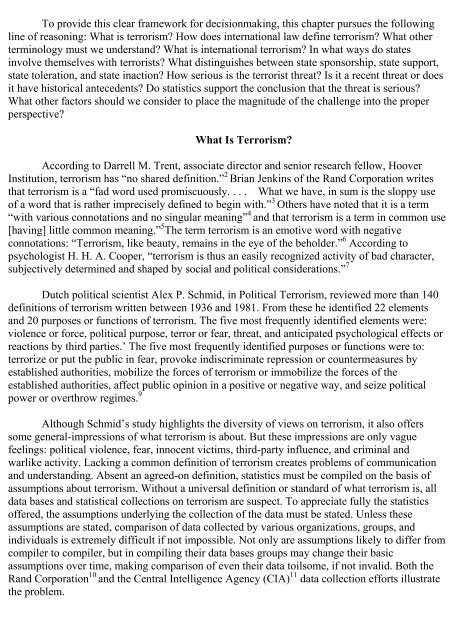Legitimate use of military force against state-sponsored - Air University
Legitimate use of military force against state-sponsored - Air University
Legitimate use of military force against state-sponsored - Air University
Create successful ePaper yourself
Turn your PDF publications into a flip-book with our unique Google optimized e-Paper software.
To provide this clear framework for decisionmaking, this chapter pursues the following<br />
line <strong>of</strong> reasoning: What is terrorism? How does international law define terrorism? What other<br />
terminology must we understand? What is international terrorism? In what ways do <strong>state</strong>s<br />
involve themselves with terrorists? What distinguishes between <strong>state</strong> sponsorship, <strong>state</strong> support,<br />
<strong>state</strong> toleration, and <strong>state</strong> inaction? How serious is the terrorist threat? Is it a recent threat or does<br />
it have historical antecedents? Do statistics support the conclusion that the threat is serious?<br />
What other factors should we consider to place the magnitude <strong>of</strong> the challenge into the proper<br />
perspective?<br />
What Is Terrorism?<br />
According to Darrell M. Trent, associate director and senior research fellow, Hoover<br />
Institution, terrorism has “no shared definition.” 2 Brian Jenkins <strong>of</strong> the Rand Corporation writes<br />
that terrorism is a “fad word <strong>use</strong>d promiscuously. . . . What we have, in sum is the sloppy <strong>use</strong><br />
<strong>of</strong> a word that is rather imprecisely defined to begin with.” 3 Others have noted that it is a term<br />
“with various connotations and no singular meaning” 4 and that terrorism is a term in common <strong>use</strong><br />
[having] little common meaning.” 5 The term terrorism is an emotive word with negative<br />
connotations: “Terrorism, like beauty, remains in the eye <strong>of</strong> the beholder.” 6 According to<br />
psychologist H. H. A. Cooper, “terrorism is thus an easily recognized activity <strong>of</strong> bad character,<br />
subjectively determined and shaped by social and political considerations.” 7<br />
Dutch political scientist Alex P. Schmid, in Political Terrorism, reviewed more than 140<br />
definitions <strong>of</strong> terrorism written between 1936 and 1981. From these he identified 22 elements<br />
and 20 purposes or functions <strong>of</strong> terrorism. The five most frequently identified elements were:<br />
violence or <strong>force</strong>, political purpose, terror or fear, threat, and anticipated psychological effects or<br />
reactions by third parties.’ The five most frequently identified purposes or functions were to:<br />
terrorize or put the public in fear, provoke indiscriminate repression or countermeasures by<br />
established authorities, mobilize the <strong>force</strong>s <strong>of</strong> terrorism or immobilize the <strong>force</strong>s <strong>of</strong> the<br />
established authorities, affect public opinion in a positive or negative way, and seize political<br />
power or overthrow regimes. 9<br />
Although Schmid’s study highlights the diversity <strong>of</strong> views on terrorism, it also <strong>of</strong>fers<br />
some general-impressions <strong>of</strong> what terrorism is about. But these impressions are only vague<br />
feelings: political violence, fear, innocent victims, third-party influence, and criminal and<br />
warlike activity. Lacking a common definition <strong>of</strong> terrorism creates problems <strong>of</strong> communication<br />
and understanding. Absent an agreed-on definition, statistics must be compiled on the basis <strong>of</strong><br />
assumptions about terrorism. Without a universal definition or standard <strong>of</strong> what terrorism is, all<br />
data bases and statistical collections on terrorism are suspect. To appreciate fully the statistics<br />
<strong>of</strong>fered, the assumptions underlying the collection <strong>of</strong> the data must be <strong>state</strong>d. Unless these<br />
assumptions are <strong>state</strong>d, comparison <strong>of</strong> data collected by various organizations, groups, and<br />
individuals is extremely difficult if not impossible. Not only are assumptions likely to differ from<br />
compiler to compiler, but in compiling their data bases groups may change their basic<br />
assumptions over time, making comparison <strong>of</strong> even their data toilsome, if not invalid. Both the<br />
Rand Corporation 10 and the Central Intelligence Agency (CIA) 11 data collection efforts illustrate<br />
the problem.
















